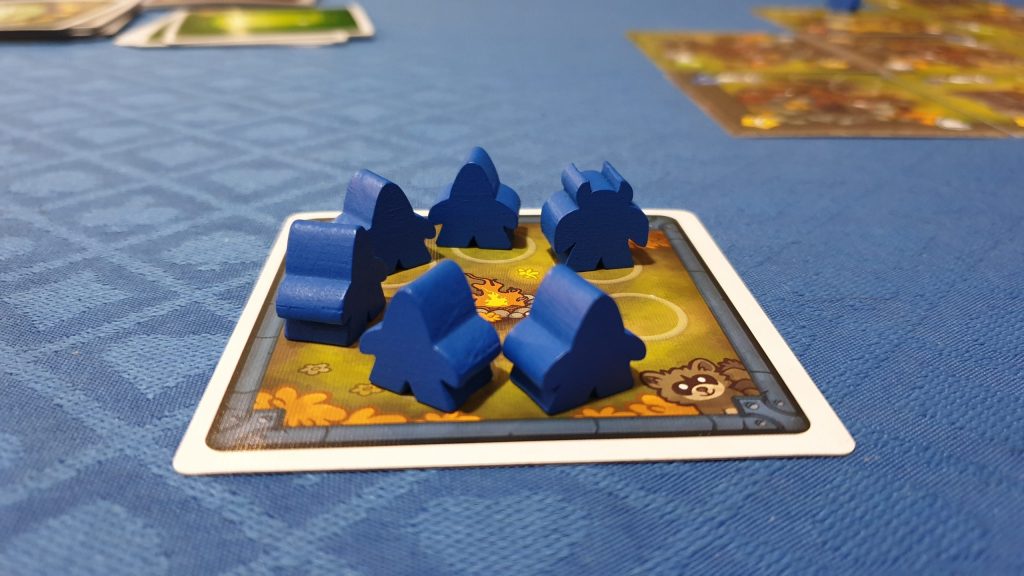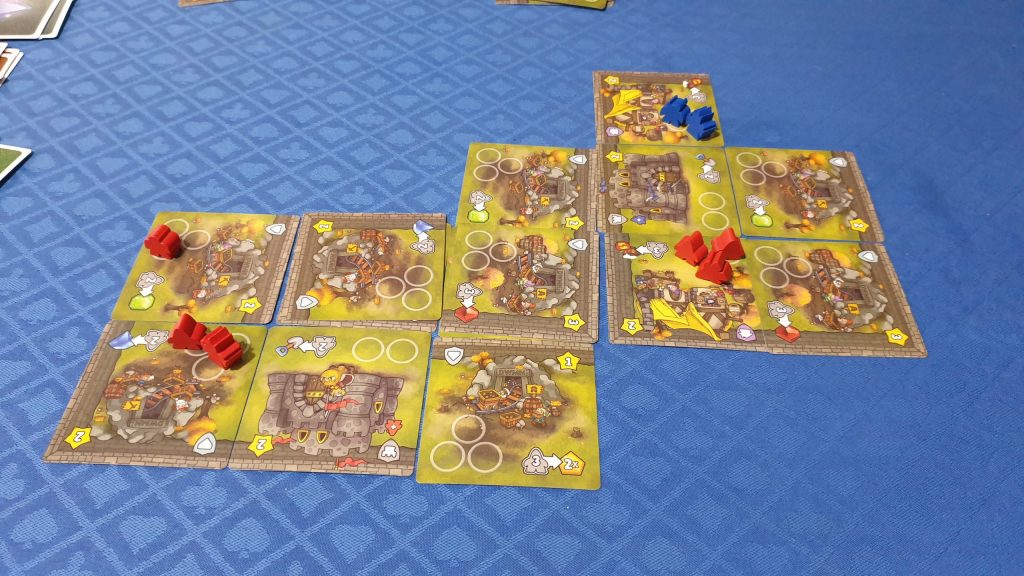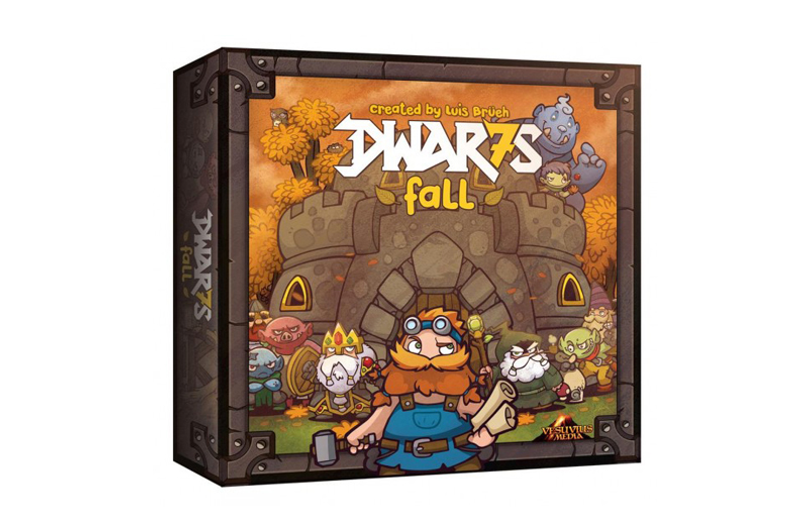Dwar7s Fall is a tile and worker placement board game from publisher Vesuvius Media. Being both the designer behind the game and the artist it is fair to say the game is by Luís Brüeh. The game sees 2 – 4 players building castles, collecting shiny gems and defeating monsters – all taking around 45 minutes. A collectors edition has just been released, though this review is based upon the standard edition. However, while the dwarfs will be placed across a growing kingdom will players grow to love Dwar7s Fall? Let’s find out!
For setup each player chooses a colour, taking the associated kingdom cards and meeples. Placing their campfire in front of them players add all standard meeples to the campfire card, with the three special meeples off to one side. Players then gain a secret objectives card, while 3 public trading objectives are unveiled. Nothing is placed to start the central kingdom, that is left to players during the game.
Throughout the game players take turns performing 3 actions at a time, before resolving any fulfilled action slots. To expand the kingdom players can play a kingdom card from their hand. After the first, which can go anywhere, each card must be adjacent to a previously played card. Cards can also be placed over the top of previously placed cards – if their type matches and the card is meeple free. Each card features action spaces with one action type. These are available for all players – regardless of whom played the card.
To use these actions a player needs to fulfill the action space requirements, by placing meeples onto free spaces – each costing an action point. For example, the Castle action dig requires two meeples to be resolved. Both meeples must be from one player, otherwise the action is effectively blocked. Another example is the Emerald mine, used to gain an Emerald card, which has three spaces but only requires two meeples. Players can also move meeples once played. Costing 1 action a meeple can be moved to an adjacent card, though walls which are along the sides of some cards cannot be jumped.

The final regular action available to players is to spend collected gems to upgrade a worker. Discarding a worker and a gem card will see the associated upgraded worker instantly unlocked, with one of each available to be upgraded to per player. On top of scoring bonus victory points at the end of the game upgraded workers come with abilities. Ranging from being free to place to bumping an opponent’s worker from a space, each can be used as normal or for situational advantages.
By visiting the tavern players can obtain ogre cards, which are then free action to play on a future turn. The ogre cards add in a large amount of take that. While Crown allow you to take all ogre cards from another player, the rest are more about disruption. Taking the place of blocking action slots as the primary offensive tactic ogres can be rather strong. For example, Ambush, returns all workers from a space, which can disrupt plans. It can also free up the space for you to use it. Rarely do they cost the affected player more than a turn of actions, sometimes less. With such a small setback it is hard to hate the introduction of direct take that for the fun they add.
Potentially one of the most important locations for winning the game is the general store. Sending 3 meeples to one will enable the player to fulfill one of the three face up public trading objective cards during the resolve phase. This phase occurs once a player has spent their three action points, upgradeable to four when their castle is built. Players need to pay attention to their hand size, with each player only allowed 9 cards at the end of their turn. With it not possible to discard kingdom cards any gem or ogre cards taking you over 9 must be discarded, wasting actions.
The game continues with players able to spend their actions however they wish, be it placing only workers a round, only adding kingdom cards to the board, etc. or a mixture. As soon as one player has completed three objective cards, including their hidden objective and public cards, the final round is triggered. Each player up to the starting player gets one final turn before the game finishes. Points are then calculated, based on the kingdom, upgraded meeples, defeated monsters and objective cards. From your coloured castle each joined card will score or lose you points, with walls closing off the kingdom. After this whomever has the most points wins, with ties split by whomever has the most dwarf meeples left on the board.

Due to the fear of being blocked many turns see players placing workers to fully fill one action and then retrieve them. As a result the board is often relatively clear between player turns. The concept of blocking actions present in other worker placement games, which is theoretically in Dwar7s Fall, therefore has limited impact. As a result, the ability to move dwarfs is criminally underused. The idea of moving workers around once placed is a brilliant one. Still as players can place dwarfs anywhere there is very little need for the action – bar the odd time someone chooses to try out blocking.
Each player starts the game with two monsters in their hand, as kingdom cards. Both add zero points to connected lands, though they can cause havoc. Monsters come with one of two abilities, either stopping connected mines from working or castle bonus actions. It takes a game or two to fully get to grips with the opportunities which walls and overbuilding offer. The end game points look like the only benefit, though it is more than possible to screw over multiple opponents with monsters at once, just by opening up and connecting their sections of the realm. When to block a bit off or when to join vast areas together is key to successful turns in the game and the points haul at the end.
The first couple of games could be improved with a tiny addition. A small reference card for a few things like the upgraded dwarfs and their abilities, and a list of ogre abilities would result in less diving for the rulebook. Dwar7s Fall isn’t a game where the rulebook cannot leave your hand, with many picking everything up within game one. It would still be nice just to have the information to hand, even if it is as a gentle nudge.
Unlike other worker placement games the actions available slowly increase over the game. While they are the same core actions, new slots become available – so further complication isn’t added. The game grows as the board does in front of players, making for a visually interesting experience – especially with all of the zig-zagging walls. To encourage players to build out the core kingdom the end game points aren’t actually the main driver. The use of a hand limit, combined with having 9 cards which you cannot discard, forces players to play at least some kingdom cards. Else players find themselves unable to collect enough gems for the objectives, nor will they be able to cause much havoc with the ogres.
Dwar7s Fall is an interesting worker placement game where the board grows in front of you. At the start the action spaces are tight, with players grabbing quick gems. By the end there is a sprawling map, with players looking to eke out a kingdom advantage. The most divisive element is the quantity of take that. Having the ogre cards be a free action means they are always being played. This creates a rather interactive worker placement game. If you can’t handle plans having monsters not just spanners thrown in the works the experience may not be for you. Yet, for those whom dislike everyone playing their own game there is plenty of entertainment available, with a good amount of choices available each turn.
(Editor’s Note: Dwar7s Fall was provided to us for the review by Vesuvius Media at Essen Spiel 2019)

